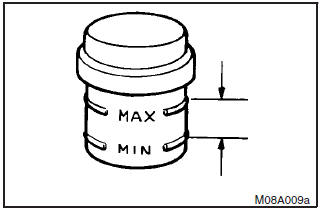Brake fluid

Check the brake fluid level in the reservoir. The brake fluid level must be between the “MAX” and “MIN” marks on the reservoir. The fluid level falls slightly with wear of the brake pads, but this does not indicate any abnormality.
If the brake fluid level falls markedly in a short length of time, it indicates leaks from the brake system.
If this occurs, have the vehicle checked by an authorized MITSUBISHI dealer.
Use brake fluid conforming to DOT3 or DOT4. The brake fluid is hygroscopic. Too much moisture in the brake fluid will adversely affect the brake system, reducing the brake performance.
In addition, the brake fluid reservoir is equipped with a special cap to prevent the entrance of air, and this cap should not be removed.
The brake fluid level is monitored by a float. When the brake fluid level falls below the “MIN” mark, the brake fluid warning lamp lights up.
WARNING
(1) Take care in handling brake fluid as it is harmful to the eyes and
may also cause damage to painted surfaces. If fluid is spilt, wipe it up as soon
as possible.
(2) Use only the specified brake fluid. Also, the additives in different
brands may result in a chemical reaction when mixed together, so avoid mixing different
brands if possible.
(3) Normally, keep the reservoir tank cap closed to prevent
the brake fluid from deteriorating.
See also:
Tyre rotation
Tyre wear varies with vehicle conditions, road surface conditions and individual
driver’s driving habits. To equalize the wear and help extend tyre life, it is recommended
to rotate the tyres ...
Supplemental restraint system (SRS) - air bag
The information written in this supplemental restraint system (SRS) section contains
important points concerning the driver, front passenger, side air bags and pre-tensioner
seat belts.
The SRS a ...
Fusible links
The fusible links will melt to prevent a fire if a large current attempts to
flow through certain electrical systems.
In case of a melted fusible link, we recommend you to have your vehicle inspect ...
